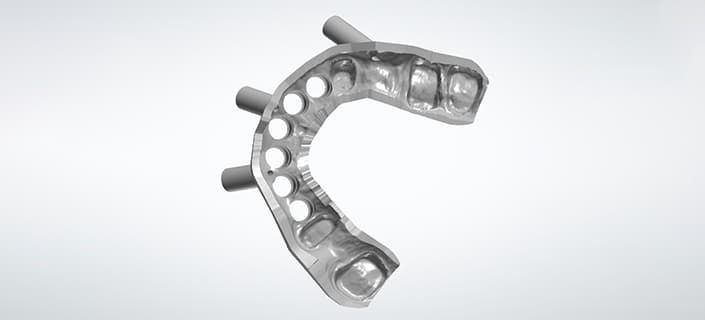The design and planning of implant surgical guides are crucial steps in the dental implantation process. They require a combination of advanced imaging technology, precise software planning and modern manufacturing techniques.
Computed tomography (CT) and digital volume tomography (DVT): These imaging techniques provide detailed 3D images of the jaw and surrounding anatomical structures. The high resolution makes it possible to accurately assess critical areas such as nerve pathways, blood vessels and the quality of the jawbone. This is crucial for planning the implant position to avoid potential complications and achieve optimal results.
Integration into the planning software: The data obtained from these scans is fed into special planning software. This software enables the dentist or dental technician to analyze the data and create a detailed treatment plan.
Use of CAD (Computer-Aided Design) software
Planning the implant position: CAD software allows the practitioner to virtually plan the optimum position, alignment and depth of each implant. This planning takes into account both functional and esthetic aspects of implant placement.
Individualized guides: Based on each patient's individual anatomy, customized guides can be designed to provide precise guidance during surgical implant placement.
Interactive functions: Modern CAD software offers interactive functions that allow the practitioner to simulate different scenarios and evaluate the effects of changes in implant position.
Integration of 3D printing technology and suitable CAD software for individual customizations
Seamless integration: CAD planning is closely linked to 3D printing technology. The designs created in the CAD software can be transferred directly to 3D printers, which physically produce the templates.
3D printing of drilling templates: 3D printing enables fast, cost-efficient and high-precision production of drilling templates. With this technology, complex geometries and fine details designed in the CAD software can be implemented precisely.
Material selection in 3D printing: In 3D printing production, various materials can be used that are specially optimized for medical use. These materials must not only be precisely printable, but also biocompatible and sterilizable.
Alternatively, drilling templates can be produced from available materials in 5-axis milling machines.
By combining these technologies, the design and planning of implant surgical guides becomes a highly precise and customized process. This approach ensures that each surgical procedure can be performed under optimal conditions, improving both patient safety and the predictability and aesthetics of the final result
